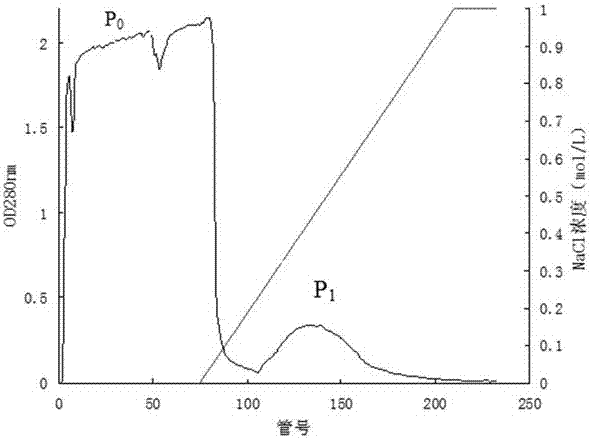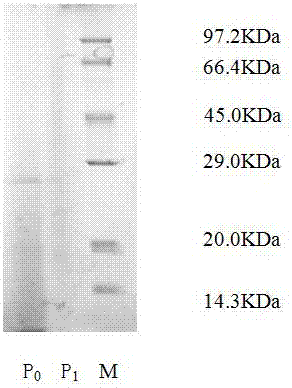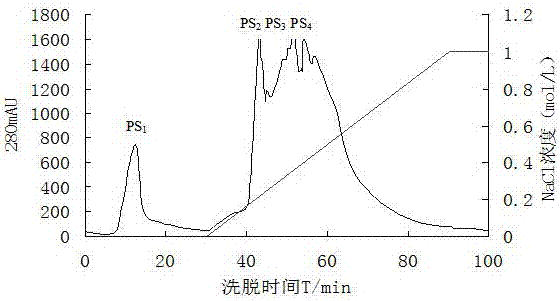Radix rehmanniae protein nano-particles and preparation method thereof
A technology of nanoparticles and rehmannia, which is applied in the field of new dosage forms and preparations of protein drugs, can solve the problems that rehmannia nanoparticles have not been reported in the literature, and achieve the effects of easy and stable storage, high safety and good resolubility
- Summary
- Abstract
- Description
- Claims
- Application Information
AI Technical Summary
Problems solved by technology
Method used
Image
Examples
Embodiment 1
[0031] Example 1: Extraction of Rehmannia Protein DHP1
[0032] Fresh Rehmannia glutinosa was ground by a juicer, the ratio of solid to liquid was 1:3, 0.2 mol / L, pH 7.0 phosphate buffer was added to mix evenly, placed at 4°C, stirred and extracted for 24 h; Extract the liquid, discard the filter residue, centrifuge the filtrate at 15000 rpm for 20 min at 4 °C, and collect the supernatant; under the condition of magnetic stirring at 4 °C, slowly add anhydrous ammonium sulfate to the extract of rehmannia glutinosa to make the solution salt. The concentration reached 20%. After it was completely dissolved, it was allowed to stand at 4 °C for 4 h, centrifuged at 12,000 rpm for 20 min, and the supernatant was collected; continue to slowly add anhydrous ammonium sulfate to the collected supernatant until the saturation was 40%. After complete dissolution, collect the supernatant in the same steps as before; continue to add ammonium sulfate to the supernatant until the saturation is...
Embodiment 2
[0035] Example 2: Extraction of Rehmantin DHP2
[0036] Rehmannia glutinosa was ground by a high-speed pulverizer, and phosphate buffer solution of 0.2 mol / L and pH 7.0 was added at a ratio of 1:3 to mix evenly, placed at 4 °C, and stirred for leaching for 24 h; Extract the liquid, discard the filter residue, centrifuge the filtrate at 15000 rpm for 20 min at 4 °C, and collect the supernatant; under the condition of magnetic stirring at 4 °C, slowly add anhydrous ammonium sulfate to the extract of rehmannia glutinosa to make the solution salt. The concentration reached 20%. After it was completely dissolved, it was left standing at 4 °C for 4 h, centrifuged at 12,000 rpm for 20 min, and the supernatant was collected; continue to slowly add anhydrous ammonium sulfate to the collected supernatant until the saturation was 40%. After complete dissolution, collect the supernatant in the same steps as before; continue to add ammonium sulfate to the supernatant until the saturation i...
Embodiment 3
[0039] Example 3: Preparation of retinoid nanoparticles
[0040] The retinoid was prepared into a 1 mg / mL pH 6.5 salt solution, heated at 70° C. for 1 hour, and the unreacted retinoid was removed by TSK gelG6000PW gel chromatography to obtain the retinoid nanoparticles. The properties of retinoid nanoparticles were studied by dynamic light scattering, multi-angle laser light scattering and scanning electron microscopy. The electron microscope observation map of retinoids nanoparticles is attached Figure 9 .
[0041] The particle size and surface potential were measured with a laser particle size analyzer, and the average particle size was measured to be 120.61 ± 0.46 nm, and the surface charge was negative, ranging from -18 ± 5mV. The size distribution of rehmantin nanoparticles is shown in the attached Figure 10 .
PUM
| Property | Measurement | Unit |
|---|---|---|
| particle size | aaaaa | aaaaa |
| molecular weight | aaaaa | aaaaa |
Abstract
Description
Claims
Application Information
 Login to View More
Login to View More - R&D
- Intellectual Property
- Life Sciences
- Materials
- Tech Scout
- Unparalleled Data Quality
- Higher Quality Content
- 60% Fewer Hallucinations
Browse by: Latest US Patents, China's latest patents, Technical Efficacy Thesaurus, Application Domain, Technology Topic, Popular Technical Reports.
© 2025 PatSnap. All rights reserved.Legal|Privacy policy|Modern Slavery Act Transparency Statement|Sitemap|About US| Contact US: help@patsnap.com



